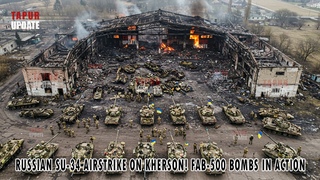BREAKING: Russia Announces 5 World’s Most Powerful Weapons, World In Shock!
BREAKING: Russia Announces 5 World’s Most Powerful Weapons, World In Shock!
Amidst the ongoing Russia-Ukraine Conflict, Russia has made substantial strides in expanding its naval capabilities. The notable developments in the country’s naval prowess were recently underscored by President Vladimir Putin during the inauguration ceremony at the Northern Shipyard in St. Petersburg. This significant event saw the unveiling of three new naval vessels, namely the multi-purpose missile frigate ’Admiral Golovko,’ the small missile ship ’Naro-Fominsk,’ and the minesweeper ’Lev Chernavin.’ The inauguration ceremony, a testament to Russia’s commitment to bolstering its naval strength, was a momentous occasion where Putin personally raised the naval flag on the ’Admiral Golovko.’
If You Like This Video: Like, Share, Comment And Subscribe. This Means A Lot To Us!
Thanks For Watching Our Video: BREAKING: Russia Announces 5 World’s Most Powerful Weapons, World In Shock!
Putin, in his address, shed light on the flourishing shipbuilding industry in Russia, bringing attention to ongoing projects that encompass a diverse range of vessels. The projects in progress include five frigates, eight corvettes, 13 small missile ships, and over 50 other vessels at various stages of construction. This ambitious undertaking, as emphasized by Putin, mirrors the nation’s unwavering dedication to fortifying its naval capabilities.
The ’Admiral Golovko,’ a noteworthy addition to the ’Admiral Gorshkov’-class multi-role frigates, stands out as the first serial-produced ship of its kind. Putin praised the vessel, highlighting its significance as a key component of the fleet’s attack groups in distant sea and ocean zones. This frigate, equipped with advanced technology and Kalibr cruise missiles, is poised to become the inaugural carrier of the recently introduced Zircon hypersonic missiles.
In a broader naval expansion initiative, Putin also inaugurated two fourth-generation nuclear-propelled submarines, namely ’Emperor Alexander III’ and ’Krasnoyarsk.’ These submarines, constructed in Severodvinsk, are slated to join the Russian Navy’s Pacific Fleet. The ’Emperor Alexander III,’ part of Russia’s strategic Borei-class series, is armed with Bulava intercontinental ballistic missiles and torpedo tubes. On the other hand, the ’Krasnoyarsk,’ belonging to the Yasen-M family, carries a diverse array of munitions, including torpedoes, naval mines, and advanced missiles like Kalibr, Oniks, and potentially Zircon.
Putin’s active involvement in these naval inaugurations serves as a clear indication of Russia’s strategic focus on modernizing its fleet and maintaining a robust presence in maritime security. The investments in cutting-edge technology and weaponry underline the nation’s commitment to staying at the forefront of naval capabilities.
Delving deeper into the arsenal at Russia’s disposal, one cannot ignore the formidable RS-28 Sarmat, touted as the “world’s deadliest missile.“ Recently deployed for combat duty, this intercontinental ballistic missile (ICBM) has officially assumed a “combat alert posture,“ marking a significant milestone in Russia’s strategic defense capabilities. Referred to as Satan II in the West, the RS-28 Sarmat boasts a super-heavy design and a thermonuclear warhead with a remarkable range of 18,000 kilometers. Notably, its capacity to carry 15 light nuclear warheads, thanks to Multiple Independently Targetable Reentry Vehicles (MIRVs), sets it apart as a multi-tasking powerhouse.
The RS-28 Sarmat is not merely an ordinary missile; it’s a heavyweight, silo-based ICBM with a liquid-propellant orbital design. Introduced in 2018, this missile has been hailed as the “most dangerous“ globally, emphasizing its speed, range, precision, and the ability to penetrate anti-missile defense systems without vulnerability. The increased destructive range of the RS-28 Sarmat is anticipated to significantly boost Russia’s strategic nuclear forces.
Shifting the focus to the naval arena, the Imperator Alexander III submarine showcased its capabilities by successfully test-launching a Bulava intercontinental ballistic missile. This naval heavyweight, with its capacity for up to six nuclear warheads, demonstrated precision by hitting a target thousands of kilometers away on the Kamchatka peninsula in the Russian Far East. The resurgence of the Topol intercontinental ballistic missiles, previously decommissioned, is also making waves in strategic discussions. These missiles, known as SS-25 or Sickle, could potentially be repurposed for strategic purposes, particularly in Ukraine.
The Topol, the Soviet Union’s first mobile intercontinental ballistic missile, possesses an impressive range of 11,000 kilometers and a payload capacity of around 1000 kilograms. While initially slated for retirement by 2020, the aging Topol ICBMs could find a renewed purpose in targeting Ukraine’s critical infrastructure.
More Details In The Video























